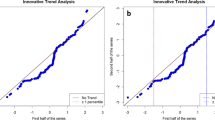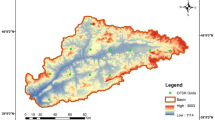Abstract
Drought is a frequently occurring natural hazard in many parts of the world and affects economy, environment and human lives. In India, the western states are severely affected by droughts. Global warming and climate change is causing more frequent and intense droughts in the region. In the present study, meteorological drought is studied using standardized precipitation index for four different timescales of 1, 3, 6 and 12 months. Drought homogeneous regions are identified over 81 stations in three western states of India using monthly precipitation data from 1901 to 2002. Based on fuzzy c-means clustering algorithm and five cluster validity indices, the optimal number of clusters obtained for 1-, 3-, 6- and 12-month timescales are 4, 5, 3 and 4, respectively. Homogeneity of the clusters is ensured using two L-moment-based homogeneity tests (H-Test). Clusters obtained for different timescales are compared and significant variation in cluster pattern is observed for different timescales. The identified regions are anticipated to assist policy maker in effective planning and management of water resources during drought.




Similar content being viewed by others
References
American Meteorological Society (AMS) (2004) Statement on meteorological drought. Bull Am Meteorol Soc 85:771–773
Bezdek JC (1974a) Numerical taxonomy with fuzzy sets. J Math Biol 1(1):57–71
Bezdek JC (1974b) Cluster validity with fuzzy sets. J Cybern 3(3):58–72
Bezdek JC (1981) Pattern recognition with fuzzy objective function algorithms. Plenum Press, New York
Blain GC (2011) Standardized precipitation index based on Pearson type III distribution. Rev Bras Meteorol 26(2):167–180
Clausen B, Pearson CP (1995) Regional frequency analysis of annual maximum streamflow drought. J Hydrol 173:111–130
Dunn JC (1973) A fuzzy relative of the ISODATA process and its use in detecting compact well-separated clusters. J Cybern 3(3):32–57
Fukuyama Y, Sugeno M (1989) A new method of choosing the number of clusters for the fuzzy c-means method. In: Proceedings of Fifth Fuzzy Systems Symposium, vol 247, pp 247–250
Goyal MK, Gupta V (2014) Identification of homogeneous rainfall regimes in Northeast Region of India using fuzzy cluster analysis. Water Resour Manage 28(13):4491–4511
Goyal MK, Gupta V (2016) Hydrological Drought: Water Surface and Duration Curve Indices, Chapter 04 in Handbook of Drought and Water Scarcity (HDWS), Francis and Taylor, CRC Group (Accepted)
Goyal MK, Ojha CSP (2012) Downscaling of precipitation on a lake basin: evaluation of rule and decision tree induction algorithms. Hydrol Res 43(3):215–230
Goyal MK, Sharma A (2016) Regionalization of Drought Prediction, Chapter 15 in Handbook of Drought and Water Scarcity (HDWS), Francis and Taylor, CRC Group (Accepted)
Guttman NB (1999) Accepting the standardized precipitation index: a calculation algorithm. J Am Water Resour As 35(2):311–322
Halkidi M, Batistakis Y, Vazirgiannis M (2001) On clustering validation techniques. J IntellInfSyst 17:107–145
Hayes MJ, Svoboda MD, Wilhite DA, Vanyarkho OV (1999) Monitoring the 1996 drought using the standardized precipitation index. Bull Am Meteorol Soc 80(3):429–438
Hisdal H, Tallaksen LM (2003) Estimation of regional meteorological and hydrological drought characteristics: a case study for Denmark. J Hydrol 281(3):230–247
Hosking JRM, Wallis JR (1993) Some statistics useful in regional frequency analysis. Water Resour Res 29(2):271–281
Hosking JRM, Wallis JR (1997) Regional frequency analysis: an approach based on L-moments. Cambridge University Press, Cambridge
Jain SK, Keshri R, Goswami A, Sarkar A (2010) Application of meteorological and vegetation indices for evaluation of drought impact: a case study for Rajasthan, India. Nat Hazards 54(3):643–656
Keyantash J, Dracup JA (2002) The quantification of drought: an evaluation of drought indices. Bull Am Meteorol Soc 83(8):1167–1180
Kwon SH (1998) Cluster validity index for fuzzy clustering. Electron Lett 34(22):2176–2177
Lettenmaier DP, McCabe G, Stakhiv EZ (1996) Global climate change: effects on hydrologic cycle. In: Mays LW (ed) Water Resources Handbook, Part V. McGraw-Hill, New York
Liu X, Wang S, Zhou Y, Wang F, Li W, Liu W (2015) Regionalization and spatiotemporal variation of drought in China based on standardized precipitation evapotranspiration index (1961–2013). Adv Meteorol 2015(950262):1–18
Lloyd-Hughes B, Saunders MA (2002) A drought climatology for Europe. Int J Climatol 22(13):1571–1592
Madsen H, Mikkelsen PS, Rosbjerg D, Harremoës P (1998) Estimation of regional intensity-duration-frequency curves for extreme precipitation. Water Sci Technol 37(11):29–36
McKee TB, Doesken NJ, Kleist J (1993) The relationship of drought frequency and duration to timescales. In: Proceedings of the 8th conference on applied climatology, vol 17, No 22. American Meteorological Society, Boston, pp 179–183
Mirakbari M, Ganji A, Fallah SR (2010) Regional bivariate frequency analysis of meteorological droughts. J Hydrol Eng 15(12):985–1000
Mishra AK, Desai VR (2005) Drought forecasting using stochastic models. Stoch Environ Res Risk Assess 19(5):326–339
Mishra AK, Singh VP (2009) Analysis of drought severity‐area‐frequency curves using a general circulation model and scenario uncertainty. J Geophys Res Atmos 114(D6):2156–2202
Mishra AK, Singh VP (2010) A review of drought concepts. J Hydrol 391(1):202–216
Pai DS, Sridhar L, Guhathakurta P, Hatwar HR (2011) District-wide drought climatology of the southwest monsoon season over India based on standardized precipitation index (SPI). Nat Hazards 59(3):1797–1813
Pal NR, Bezdek JC (1995) On cluster validity for the fuzzy c-means model. IEEE Trans Fuzzy Syst 3(3):370–379
Rajsekhar D, Mishra AK, Singh VP (2011) Drought regionalization of brazos river basin using an entropy approach. In: 2011 Symposium on data-driven approaches to droughts. Paper 40
Rajsekhar D, Mishra AK, Singh VP (2012) Regionalization of drought characteristics using an entropy approach. J Hydrol Eng 18(7):870–887
Rao AR, Srinivas VV (2006) Regionalization of watersheds by fuzzy cluster analysis. J Hydrol 318(1):57–79
Raziei T, Bordi I, Pereira LS (2008) A precipitation-based regionalization for Western Iran and regional drought variability. Hydrol Earth Syst Sci 12(6):1309–1321
Riebsame WE, Changnon SA, Karl TR (1991) Drought and natural resources management in the United States. Impacts and implications of the 1987–89 drought. Westview Press Inc
Sahoo RN, Dutta D, Khanna M, Kumar N, Bandyopadhyay SK (2015) Drought assessment in the Dhar and Mewat Districts of India using meteorological, hydrological and remote-sensing derived indices. Nat Hazards 77(2):733–751
Santos JF, Portela MM, Pulido-Calvo I (2011) Regionalization of droughts in Portugal. River Basin Manag VI 146:239
Sen Z (1980) Statistical analysis of hydrologic critical droughts. J. Hydraulics Div., ASCE 106 (1), 99–115
Urcid G, Ritter GX (2012) C-means clustering of lattice auto-associative memories for endmember approximation. In: Graña M, Toro C, Posada J, Robert J Howlett, Lakhmi C Jain (eds) Advances in Knowledge-Based and Intelligent Information and Engineering Systems (pp 2140–2149). IOS Press
Vasiliades L, Loukas A, Patsonas G (2009) Evaluation of a statistical downscaling procedure for the estimation of climate change impacts on droughts. Nat Hazards Earth Syst Sci 9(3):879–894
Wilhite DA (2000) Drought as a natural hazard: concepts and definitions. Drought: A Global Assessment. Routledge, London
Wilhite DA, Glantz MH (1985) Understanding: the drought phenomenon: the role of definitions. Water Int 10(3):111–120
Wu H, Svoboda MD, Hayes MJ, Wilhite DA, Wen F (2007) Appropriate application of the standardized precipitation index in arid locations and dry seasons. Int J Climatol 27(1):65–79
Xie XL, Beni G (1991) A validity measure for fuzzy clustering. IEEE Trans Pattern Anal Mach Intell 8:841–847
Author information
Authors and Affiliations
Corresponding author
Rights and permissions
About this article
Cite this article
Goyal, M.K., Sharma, A. A fuzzy c-means approach regionalization for analysis of meteorological drought homogeneous regions in western India. Nat Hazards 84, 1831–1847 (2016). https://doi.org/10.1007/s11069-016-2520-9
Received:
Accepted:
Published:
Issue Date:
DOI: https://doi.org/10.1007/s11069-016-2520-9




